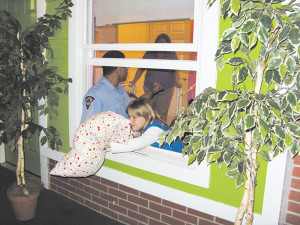Vincent Randolph, an educator at the Survive Alive program, pushes the smoke detector button and the room is filled with the squeal of the alarm, and the squeals of the Girl Scouts in the classroom. “What does this sound mean?” he shouts above the din. The Girl Scouts shriek “there’s a fire!” or “there’s smoke!” One little girl pipes up, “It means Mom’s cooking again!” and the room bursts into laughter.
After the giggles die down, Randolph continues the educational part of the program. The smoke detector’s inner workings are explained. The girls practice “stop, drop, cover, and roll” (the parents do as well, although not as elegantly). The Scouts learn about “fall and crawl” when they hear the smoke detector alarm — falling to their knees and crawling to safety. They learn to keep the bedroom door shut at bedtime — a closed door acts as a barrier in a house fire. The girls see how firefighters get ready to fight a fire, and see how the 70 pounds of equipment protects them in a fire so they can rescue a family. Hands fly into the air to ask questions, and Randolph and the other educators, Lana Neiderhauser and Clara Simeone, patiently explain how to survive a fire.
The director of the Survive Alive program, Captain Aleatha Henderson, stands by and watches the classroom portion of the session. Started in 1985, Survive Alive program in Indianapolis has seen over 150,000 children come through the doors. She notes that the children who come through remember what they learn in the two hours spent in the learning and laughing. “Just in the last month or two, six people escaped from a house fire because the parent and one of the children had been through the program and remembered what to do. Recently, a nine year old who went through the program helped his family during an apartment fire. He taught his brothers and sisters what to do and they practiced, and everyone got out safely.”
Beyond anecdotes, Captain Henderson has seen the studies that push home the fact that appropriate safety and fire education saves lives. Those studies reveal that since the Survive Alive program was implemented and in-school programs boosted, child fatalities in fires has decreased 70 percent. “We know it works,” she said.

Photo by Ethel Winslow/Weekly View
A Girl Scout learns how to escape safely from a bedroom on the first floor in the Survive Alive program.
The Survive Alive facility is located downtown at 748 Massachusetts Ave. in an historic building that is also home to the Indianapolis Fire Museum. There is classroom space, plus a mock “village” and home, where children learn about how to prevent fires and accidents. They also learn how to escape from a fire from a bedroom — an important lesson, since most home fires start between 11 p.m. and 6 a.m. The fire educators carefully explain the do’s and don’ts of getting out, calling for help, and waiting for the fire trucks to get there. After the two hours, participants receive a certificate of completion.
Captain Henderson said that there are two programs offered — one for 1st and 2nd grade students (Survive Alive), and another for 5th and 6th graders, called Kids in Charge, that includes information on safety in environmental emergencies, such as chemical spills releasing toxins in a neighborhood.
It’s a lot of information for kids to digest. However, the three educators do a great job of keeping the girls interested, showing them step by step what to do in case of an emergency. They show the girls how to help their families, and emphasize reviewing safety information regularly with their parents and their siblings and friends. They review how to call 911 and what information to give. They also hear what the call sounds like at the firehouse when the call comes in — and what to expect when the firefighters arrive at the scene.
Randolph said that the staff at Survive Alive stay busy, offering at least two sessions a day for groups to come come through. They also go to schools to do safety and fire education, and community events. The program is free and open to all groups.
Survive Alive is a program of the Indianapolis Fire Department, and the building it is in is owned by Local 416 Firefighters Union, who donate the space. The City pays the firefighter’s salaries, but the program relies on sponsors and donations to pay for upkeep. For more information about bringing a group to the Survive Alive program or to make a donation, visit www.survivealive.org or call 327-6707.



